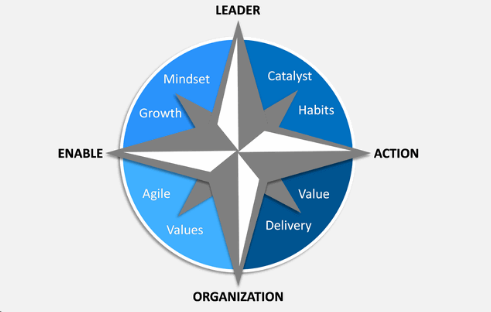The future of work is in teams, not in individuals. Cooperation and trust between employees have become crucial as organizations mobilize to solve problems that are getting more complex at a faster rate. But how do you get your teammates to stop acting in a collegial manner and start working together effectively? they develop compassion and empathy.
Table of Contents
The Importance Of Achieving Commonality
I once enjoyed going to a client’s yearly summer party a number of years ago. The company takes great pride in organizing a fun event that delights workers and their families, shows appreciation for the accomplishments of the workers, and forges bonds between the various departments and operating units.
Tug-of-war is one of the most exciting event customs. The trophy is a tall, vintage piece from a dance studio, and it has a space for the winning team’s name to be engraved on it. The traveling trophy is made more appealing in some way by the image of a graceful dancer on top. The two teams, “Office” and “Production,” are required to have even numbers, so great care goes into the selection of their representatives; and most of the participants use athletic cleats and heavy gloves. In front of jeers and cries that the results would be different the following year, the Office team rather unexpectedly defeats Production as I watch.
Despite the activity’s design appearing to be a little lighthearted fun, it actually has a very competitive vibe to it. Like many businesses, this one exhibits some mistrust and possibly even disrespect between its white-collar and blue-collar workers. Back at the factory, it’s possible that the engineers do not believe that the production staff perfectly complies with specifications, and it’s also possible that the production staff does not believe that payroll accurately calculates their hours and paid time off. Whatever the situation, I have a suspicion that there is internal conflict within the company and that everyone needs to feel a sense of unity.
Is Everyone On Your Team Working Together?

To succeed in the ongoing competition for market share, customers, resources, and talent, the organizational commonality is crucial. There is a constant tug-of-war going on with rival companies, and the company is less likely to succeed unless its team is working cohesively. Each function in the organization becomes like a hand on the overall rope when the organization’s systems are aligned, and physics and mechanics dictate that the pull on the rope is stronger.
Finding Commonality:
3 ways your organization can become greater than the sum of its parts
The steps for establishing a shared vocabulary, a shared operating model, and a shared understanding within an organization are outlined below, along with how doing so will help your company produce its best outcomes.
1. Common Understanding
- Everybody is aware of the organization’s purpose.
- Everyone agrees on what the organization is and is not, based on shared values.
- Everyone agrees that the organization must change in order to improve.
- All understand the possibilities and the “what-ifs” that can make the organization better.
- Everyone is aware that pursuing personal goals will not advance the organization.
- Each person can visualize what it looks like to win.
A business leader recently mentioned the “tug-of-war” that often happens between IT and other corporate divisions. He notes that although they are not brought in when things are going well, IT typically draws its point of reference from the issues that they are asked to solve. The other department typically thinks IT should foresee problems and respond more quickly, and as a result, IT readily concludes that much is wrong in the other department. Without an understanding of one other, neither department values the other’s contribution to the company’s success in achieving its strategy.
2. Common Language
- The team’s DNA is formed through processes that result from using a common language (terminology).
- The achievement of an organization’s objectives is greatly aided by its sense of distinctive culture, which is created by its shared language.
- Express the common language in “the way we do things” or in a process or technology that solves internal organizational problems.
- Decide, share, and uphold your rights to make decisions.
I can think of a military attack pilot experience as an illustration of this. Attack terms like “destroy,” “attrit,” “delay,” “disrupt,” “reconnaissance,” “secure,” or “defend” are used when a mission is assigned to an attack squadron. Each of these phrases was chosen with care because, from the perspective of a pilot, they all refer to very different things from a doctrinal standpoint. By using a common language, pilots can plan and carry out their assigned mission more quickly and with less confusion.
Another example that comes to mind is the term “ROE” (Leaders of an F100 company use a document called “Rules of Engagement” to manage business development and sales. This business establishes very explicit procedures for managing its global sales efforts. These common methods of operation describe how teams from all levels and locations manage governance and hand-off leads.
Teams are better able to solve issues quickly and effectively when they speak a common language.
3. Common Operating Picture
- The operating picture, also known as the business model, establishes the framework for the language that is commonly used.
- A shared understanding of how an organization uses people, processes, and technology to deliver value is made possible by a common operating picture.
- A value-point road map (VPM) enables your team to picture the organization’s objectives. A great example is value-point mapping the customer experience and its touch points to produce a visual representation of crucial touch points with the customer and how to best achieve the organization’s strategy.
- Transform any logical divisions within the company by distributing dashboards and other technological resources.
What Does Workplace Cultural Diversity Mean?

Cultural diversity is a fundamental aspect of what it means to be human, both in business and in general. There are various types of people in the world, and each one contributes unique knowledge, expertise, and fresh viewpoints.
Forging relationships with others, development is essential. This practical education helps us become better people and establishes a respect and learning environment in the workplace.
Cultural diversity at work entails creating a workforce that not only includes but also values workers from various cultures. Diversity does refer to individuals of various racial, ethnic, gendered, and sexual orientations. However, it also goes beyond diversity on the surface.
Employees with various political philosophies, immigration statuses, and educational and professional backgrounds are also included in a truly diverse workforce. Additionally, it actively includes people with disabilities and those with neurodiversity.
4 Types Of Cultural Diversity In The Workplace
Diversity in the workplace encompasses more than just our physical appearance. Most definitions of diversity include what are referred to as protected characteristics. These characteristics or aspects of an individual’s identity are specifically exempt from discrimination under the law.
These characteristics make up a large part of what we consider diversity in the workplace, but there are other types of diversity to keep in mind:
- Age
- Gender identity, biological sex, and sexual orientation
- Race and ethnicity
- Disability
1. Age
Both younger and older employees have the potential to encounter discrimination at work. People might believe that Gen Z is glued to their phones, boomers are out of touch, and millennials are entitled.
The truth is that, as with any other characteristic, each generation’s lived experiences have given rise to unique ways of viewing the world, and everyone can profit from learning from those experiences. However, when viewed correctly, generational differences can be advantageous to groups and organizations.
2. Gender Identity, Biological Sex, And Sexual Orientation
Many hiring managers and people in the workforce still don’t completely grasp the concepts of gender and sexuality inclusivity. Women, non-binary individuals, and people who identify as LGBTQ+ in particular frequently deal with prejudice, insensitive personal inquiries, and assumptions about their way of life or identity.
3. Race And Ethnicity
One of the pillars of diversity initiatives is ethnic identity. However, people often tend to stop here, which can leave diverse employees feeling “othered” or as if they’re present to fill a quota. Coworkers who harbor animosity toward their non-white coworkers may result from this attitude spreading throughout the company.
4. Disability
Physical limitations, mental health issues, and neurodiversity can all be considered disabilities. Although many businesses list diversity as a top value, the vast majority of them lack the tools necessary to recruit, keep, and assist disabled workers.
A disability of some kind is a reality for nearly 20% of the adult workforce. Since the majority of those conditions are invisible, it’s likely that education and accessibility initiatives would benefit everyone in your workplace.
Benefits Of Cultural Diversity In The Workplace
Creating a truly diverse workplace has a number of significant advantages. Here are the ways that both companies and employees benefit when diversity and inclusion are core organizational values:
Trust and respect
A sense of trust and respect between coworkers is developed and nurtured in diverse workplaces. People’s individuality is valued, nobody is singled out or shunned, and everyone is urged to bring their whole selves to work.
Increased revenue
Companies see an increase in revenue in an inclusive environment, and employees do too. A wider range of customers is attracted to diverse businesses. It is possible to respond to the needs of your clients with insight and sensitivity when you develop an understanding of the various needs and experiences within your team.
Creativity and innovation
It’s not about metrics or checking boxes when it comes to diversity. Diversifying the perspectives and methods of operation on your team is the real benefit of diversity. Without embracing, celebrating, and empowering people to manifest their full selves, you won’t achieve that. Groupthink is diminished by diversity, and innovative, creative workplaces are fostered.
More collaborative teams
According to research, psychological safety is the key component of successful collaboration. Your employees’ sense of belonging will increase if you promote a culture that values cultural diversity. For psychological safety, this sense of belonging is necessary.
Improved performance and engagement
To remain anonymous at work requires effort. People are more open and engaged with their coworkers when they feel psychologically safe, which improves collaboration, increases productivity, and boosts employee engagement.
Company culture
A more welcoming and inclusive work environment is created by employers who hire a diverse pool of workers from various backgrounds, experiences, and occupations. This benefits how customers, leaders, investors, and the general public view the business.
Develops new skill sets
There are a variety of skills that people from various backgrounds bring with them. Cross-cultural learning is promoted by individuals’ sharing of their personal, educational, and employment experiences. The ability to think clearly and quickly improves, as does the capacity for problem-solving.
Reduced discrimination and harassment
In environments that are homogeneous, discrimination and harassment are more frequent. Being part of the cultural majority makes people more likely to act out their prejudices. People from underrepresented backgrounds may experience pressure to assimilate in the workplace when there is a dominant culture present. Diverse environments can act as a barrier against hostile workplace behavior.
Improved recruiting and retention
The puzzle is not entirely solved by diversity recruiting. A diverse workforce can be effectively retained if the proper environment and culture are present. Strong cultures of belonging and inclusion can be found in workplaces where diverse employees feel seen, valued, and welcomed.
Job seekers are increasingly citing work culture as a deciding factor in choosing a new job, making these environments appealing to them. Also related to employer net promoter scores (ENPS) is the relationship between employee belonging. According to the data, people perform better at work and are less likely to consider quitting when they feel like they belong at work.

5 Ways To Promote Cultural Diversity At Work
An inclusive workplace culture cannot be created overnight. If you are having trouble with this, it might be a sign that there is a deeper organizational problem with safety and trust. You cannot just say you value diversity. It needs to be demonstrated in both your company’s values and your behavior. People will pick up on when they’re being “tokenized” or “othered,” and it can actually do more harm than good.
Here are some ways for inclusive leaders to promote cultural diversity within your organization:
1. Employee resource groups
ERGs should be established and promoted at work. Employees can connect with one another in these peer-led groups, share experiences, and celebrate their differences and similarity. ERGs are open to everyone, but they are run by people from a particular group that is typically underrepresented. They can be great opportunities to foster a sense of belonging and community.
2. Implicit bias training
Everybody harbors unconscious prejudices, and everyone has some sort of privilege that they are accountable for. Spend some time challenging yourself by examining your own presumptions. Lectures on stereotypes in the workplace and diversity training seminars are both welcome. The workshop’s insights can be put into practice with the assistance of a coach.
3. Watch your language
It’s worthwhile to take another look if you haven’t updated your content and brand guidelines in a while. Now that they are no longer widely used, many once-common terms are understood to be offensive. Eliminate all ableist, sexist, racist, homophobic, or coded language from internal (employee-facing) and external (client-facing) content. During the interview process, be sure to ask questions about culture addition rather than culture fit.
4. Have courageous conversations
When racial and social justice issues come up, provide a safe space for your staff to discuss them. Recognize that they might be experiencing feelings of guilt or even rage or frustration. It’s crucial to hear about, comprehend, and validate their experience.
5. Hire a DEI expert
For many organizations, developing a diversity and inclusion strategy is uncharted territory. Add a DEIB specialist to your team if you can. They frequently benefit from broader experience across industries, whether they are employed in-house or as consultants. A specialist can help you avoid common pitfalls and learn the best methods for creating a welcoming and diverse culture.
The Importance Of Cultural Diversity In The Workplace
People desire to be accepted at work for who they truly are, which includes all aspects of who they are, rather than just certain aspects.
There are numerous benefits to having a diverse workforce. Yes, it improves the image of businesses. But more importantly, it makes them feel good, and when people feel appreciated at work, they perform better. Building a strong, inclusive, and expanding organization requires consideration of cultural diversity.
In Conclusion
Any tug-of-war can be shifted toward the objective of defeating your rivals by using commonality to foster cooperation and trust within your team. Commonalities within the organization also offer clarity when decisions need to be made, as many different factors push and pull leaders’ attention and energy. Commonality of understanding, language, and operations, in its ideal form, offers a platform from which the organization makes significant, sometimes breathtaking, advancements.





